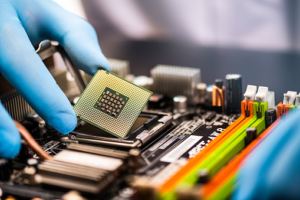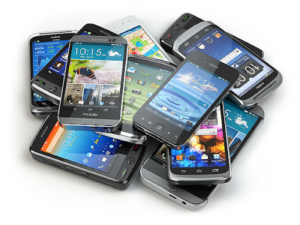Written by: Javeria Murtuza
Edited by: Ravjyot Ughra
Designed by: Jiya Mehta
Published by: Tvisha Lakhani
As social media becomes a norm in our daily lives, we’re often warned about what we put online. Everything that goes on the internet becomes permanent, and if someone looks hard enough, they can find it. All the information that a person puts online is called a “digital footprint.” Digital footprints are, of course, something to be concerned about. But what most people forget are the effects of machines used to access social media, or the internet in general.
The wastes created due to computers, phones, and machines in general are called “electronic wastes”, or “e-wastes” for short. From the moment its production starts to even after it is disposed of, a computer creates some of the most toxic wastes on the planet. The cause is not only due to inefficient company policies, but also because of global poverty, unnecessary innovation, and the lack of enthusiasm by world leaders to step in and do something about it.
Let’s start with the first step – the birth of a computer. In a factory in Asia, thousands, if not millions, of workers go through the repetitive task of putting hardware together. Whether it be a CPU, a RAM chip, a hard disk – these workers have created them so many times that the procedure is ingrained in their fingertips. Your computer may boast the label of having been made in a rich country, but truthfully, a part of every piece of technology, if not the whole thing, is produced in an impoverished area in Asia.
This isn’t a bad thing. The constant exchange of products and money is the thing that makes this world go round. The problem is the e-waste produced when manufacturing these products. And that e-waste is a lot. A single computer takes around 1500 kilograms (3300 pounds) of water, 22 kilograms (50 pounds) of chemicals, and 240 kilograms (530 pounds) of fossil fuels, and that’s excluding things like keyboards and mice. Of course, the blame for that doesn’t lie with the workers. A good number of them don’t even know about the consequences of their work, and the ones who do can care less because they have themselves and their families to worry about. If anyone should be blamed, it’s those who forced the workers into that situation then continue to turn a blind eye to its effects.
 In some cases, the parts are put together then shipped away as a fully manufactured computer. However, most of the time, the parts are shipped separately and factories that receive them put them together. Then this computer is sold to people like you and me. This is the time the computer requires the least resources but produces the most wastes. A typical computer needs 600 kilowatts of electricity, which results in 175 kilograms (400 pounds) of carbon dioxide produced, every single year. Assuming that this computer’s lifespan is 8 years at most, that’s 1400 kilograms (3200 pounds) of carbon dioxide produced just during its usage.
In some cases, the parts are put together then shipped away as a fully manufactured computer. However, most of the time, the parts are shipped separately and factories that receive them put them together. Then this computer is sold to people like you and me. This is the time the computer requires the least resources but produces the most wastes. A typical computer needs 600 kilowatts of electricity, which results in 175 kilograms (400 pounds) of carbon dioxide produced, every single year. Assuming that this computer’s lifespan is 8 years at most, that’s 1400 kilograms (3200 pounds) of carbon dioxide produced just during its usage.
Unfortunately, throwing away the computer isn’t the end of it. Disposing the computer starts another process of pollution. Most of the computers thrown away don’t end up being recycled. This includes computers that are given to electronic recycling companies. Most electronic recycling companies don’t sustainably recycle computers like how they promise. The cost of it is just too high. These companies profit more off of selling these old computers back to a third world Asian country, where the computers are dismantled and scavenged for valuable parts and metals.
The unprofitable parts are thrown away or burnt. This includes the plastic that most computers are made of. Burning plastic not only contributes to climate change, but also releases polychlorinated and polybrominated  dioxins, which are some of the most toxic chemicals on the planet. These chemicals break down the immune system and affect the nervous system, which causes a higher risk of catching a disease. The disposed parts also contain other toxic chemicals, such as mercury and cadmium. CRTs, which are used to display pictures on monitors, contain several pounds of lead. When the CRT monitors are disposed of, the lead often finds its way to water sources. This results in lead poisoning within the local populations. In addition, it also harms the surrounding plants, which causes imbalances within the food pyramid.
dioxins, which are some of the most toxic chemicals on the planet. These chemicals break down the immune system and affect the nervous system, which causes a higher risk of catching a disease. The disposed parts also contain other toxic chemicals, such as mercury and cadmium. CRTs, which are used to display pictures on monitors, contain several pounds of lead. When the CRT monitors are disposed of, the lead often finds its way to water sources. This results in lead poisoning within the local populations. In addition, it also harms the surrounding plants, which causes imbalances within the food pyramid.
The problem might not have been so severe if technology companies weren’t pushing out new models in effort to get the most profit possible. Even though Apple is infamous for adding the most useless features possible to new phone models, it surprisingly supports their older models the longest compared to other famous technology companies. Apple phones receive updates and support for 5 to 7 years. This more than doubled compared to Huawei phones, which only receive updates for 2 to 4 years. In comparison, Samsung phones are supported for 3 to 4 years. With proper care, these phones can last so much longer. But due to the lack of support, customers are forced to di spose of their devices and buy new ones, causing the cycle to restart.
get the most profit possible. Even though Apple is infamous for adding the most useless features possible to new phone models, it surprisingly supports their older models the longest compared to other famous technology companies. Apple phones receive updates and support for 5 to 7 years. This more than doubled compared to Huawei phones, which only receive updates for 2 to 4 years. In comparison, Samsung phones are supported for 3 to 4 years. With proper care, these phones can last so much longer. But due to the lack of support, customers are forced to di spose of their devices and buy new ones, causing the cycle to restart.
Ending this on a positive note is difficult to do. The problem operates on a global scale and is so interconnected with other problems, it’s difficult to fix without causing everything to collapse. A normal person like you and me can’t suddenly get up one day and make a change. But as we become more aware of the roots of the problem, we know where we can start making that change. And then all that’s left is to start.
Works Cited
- https://www.theworldcounts.com/challenges/planet-earth/waste/electronic-waste-facts
- https://www.neweggbusiness.com/smartbuyer/components/born-in-the-usa-computer-hardware-made-in-america/
- https://www.energuide.be/en/questions-answers/how-much-power-does-a-computer-use-and-how-much-co2-does-that-represent/54/
- https://www.youtube.com/watch?v=a-oLNqtTUt0
- https://www.who.int/news-room/fact-sheets/detail/dioxins-and-their-effects-on-human-health
- https://everphone.com/en/blog/smartphone-lifespan/

